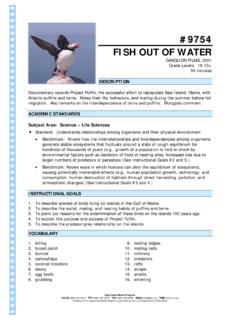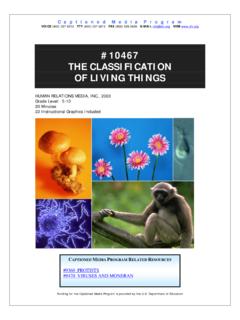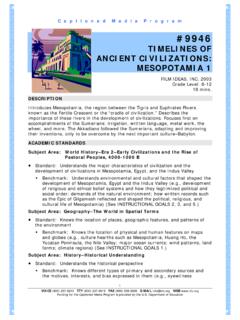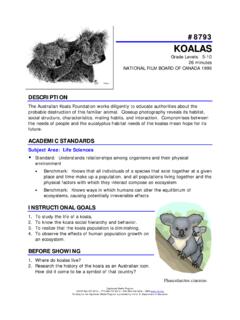Transcription of #10394 INSECT METAMORPHOSIS - Described and …
1 C a p t i o n e d M e d i a P r o g r a m VOICE (800) 237-6213 TTY (800) 237-6819 FAX (800) 538-5636 E-MAIL WEB RAINBOW EDUCATIONAL MEDIA, 2001 Grade Level: 4-8 22 Minutes Funding for the Captioned Media Program is provided by the Department of Education #10394 INSECT METAMORPHOSIS CAPTIONED MEDIA PROGRAM RELATED RESOURCES #3050 INSECT METAMORPHOSIS #10102 WAITING FOR WINGS#10514 BUTTERFLY BASICS Producer, Writer & Director: Consultants: Videography, Animation & Editing: Special Thanks To: Peter Matulavich Greg Walker, , Dept. of Entomology, University of California, Riverside Michael Worosz, , Curriculum Consultant Introduction 2 Objectives 3 Summary 4 Review Questions 7 Discussion Questions 10 Peter Matulavich Activities 12 Arthur V. Evans, , Los Angeles INSECT Zoo Bill Lewis, Bill's Bees Kirk Visscher, , Dept. of Entomology, University of California, Riverside Howard Topoff, Portal Research Station, American Museum of Natural History Video and Teacher's Guide produced for Rainbow Educational Media by Peter Matulavich Productions San Dimas, California Glossary 14 Bibliography 18 Websites 20 Script 22 Purchase of this program gives the user the right to reproduce or duplicate, in whole or in part, this teacher's guide for the purpose of teaching in conjunction with this video.
2 This right is restricted for use only with this video program. - - Any reproduction or duplication in whole or in part of this guide for any purpose other than for use with this video is prohibited This video is designed to introduce students to one of nature's most amazing events: METAMORPHOSIS , the process during which organisms experience dramatic changes in form as they grow. Many students are aware of METAMORPHOSIS in other animals, such as amphibians, where a tadpole will grow arms and legs and change into a frog. In insects, this process is every bit as dramatic, if not more so. There are two basic types of METAMORPHOSIS in insects: incomplete, or simple, METAMORPHOSIS , and complete METAMORPHOSIS . There are three stages in incomplete METAMORPHOSIS : the egg, nymph, and adult. The nymph, which hatches from the egg, is virtually a miniature version of the adult and, in a few weeks, will grow to full adult size.
3 In between, it will undergo as many as eight or more molts where it sheds its outer covering. After their last molt, most insects will develop a set of wings, usually two pairs. Insects which undergo incomplete meta- morphosis include primitive forms of insects such as roaches, aphids, katydids, and many others. There are four stages in complete METAMORPHOSIS : the egg, larva, pupa, and adult. Larvae come in a variety of forms and are referred to as caterpillars, grubs, mealworms and maggots. The video follows a monarch butterfly caterpillar on its way to becoming an adult. The larva stage is followed by the pupa stage, during which the INSECT appears to be inactive, but is actually undergoing dramatic changes within an enclosure. The butterfly pupa is referred to as a chrysalis. A fully grown adult will emerge from the pupa. Most of the world's insects, including beetles, bees, ants, flies, wasps, and countless others, undergo complete meta- morphosis.
4 2 OBJECTlUES After viewing this video, students should know: what METAMORPHOSIS is the two main types of INSECT METAMORPHOSIS the three stages in incomplete METAMORPHOSIS the four stages in complete METAMORPHOSIS that nymphs are miniature versions of adults that the primary jobs of nymphs are to eat and grow how insects molt in order to grow the names of a few of the insects which under- go incomplete METAMORPHOSIS how INSECT eggs come in a variety of forms what galls are that aquatic insects deposit their eggs under water that larvae come in a variety of forms and are referred to as caterpillars, grubs, mealworms and maggots that moth and butterfly larvae are referred to as caterpillars the butterfly pupa is referred to as a chrysalis The video opens with a fast-paced sequence featuring the METAMORPHOSIS of a monarch butterfly. The narrator then states how some organisms undergo a process, during which they experience dramatic changes in form as they grow, called METAMORPHOSIS .
5 Many stu- dents may already be familiar with METAMORPHOSIS in other animals such as amphibians so the video quickly highlights the life cycle of a frog as it transforms itself from a tiny tadpole. Insects undergo the same type of dramatic changes as they grow. The narrator explains that there are two basic types of METAMORPHOSIS in insects: incomplete, or simple, METAMORPHOSIS , and complete METAMORPHOSIS . There are three stages in incomplete METAMORPHOSIS : the egg, nymph, and adult. Some insects, such as the praying mantis, deposit their eggs in masses. A single mantis egg mass might contain more than a hundred eggs. When they hatch, tiny versions of adult praying mantises, called nymphs, emerge. Nymphs will grow into adults in a matter of weeks, but in between, they will undergo a series of molts during which they shed their outer covering. Many insects will undergo as many as eight or more molts before they reach full adult size.
6 After their last molt, most insects will develop a set of wings, usually two pairs. The video explains that the primary job of nymphs is to find food. We see that mantis nymphs have specially adapted front legs with sharp spines that are well suit- ed for the purpose of catching prey. The third and final stage of incomplete METAMORPHOSIS is the adult stage. Insects will grow no more and most will have fully developed wings. Insects which undergo incomplete METAMORPHOSIS include mantises, walkingsticks, roaches, aphids, dam- selflies, grasshoppers, katydids, backswimmers, water bugs, and many others. Since nymphs are miniature versions of adults, the nar- rator asks why do you never see miniature versions of honeybees, ants and butterflies? They are always the same size. The answer is because these insects, and countless others, undergo an entirely different type of METAMORPHOSIS called complete METAMORPHOSIS .
7 There are four stages during complete METAMORPHOSIS : the egg, larva, pupa, and adult. The video then fea- tures this process by following the METAMORPHOSIS of the monarch butterfly. It begins with a monarch but- terfly extending its abdomen to deposit an egg on a milkweed plant. A few days later, a butterfly larva will eat its way out of the egg. The larva starts out with a white body but, once it molts, it will take on black, yellow, and white stripes, colors that warn its predators that it is not good to eat. The larvae of butterflies, as well as moths, are called caterpillars, and the video features other species of caterpillars as well as other forms of larvae, including those of bees, flies, and bee- tles. The primary job of all larvae is to eat as much as they can as quickly as they can and the video features monarch larvae devouring a milkweed plant. After about a week of gorging itself, the monarch caterpillar is ready to enter the next stage of complete metamor- phosis and is shown spinning a silk thread from a gland to produce a sticky glob, called a button, on the underside of a leaf.
8 The monarch attaches its rear pro- legs to the button and then drops, hanging in a position referred to as the "j shape" because of the way it resembles the letter '3". We next see a split developing along the back side of the caterpillar as it begins to shed its old skin. As it does so, an entirely new form called the pupa begins to emerge. The pupa is shown struggling as it attempts to rid itself of its old skin. If it doesn't, the skin will interfere with the cremaster, an organ that is used by the pupa to secure itself to the button. If the old skin got in the way, the pupa would eventually lose its grip, fall to the ground, and then die. We then see the pupa's new skin turn a light green as it hardens. It eventually becomes waxy and the color of precious jade. The pupa is now referred to as a chrysalis. Interesting features of the chrysalis are the gold spots which are thought to control the color of the butterfly's developing wings.
9 In one or two weeks the chrysalis becomes transparent and you can see the entire butterfly within it. The but- terfly is then seen tearing the chrysalis open as it strug- gles to emerge. After several attempts, the butteffly, its abdomen swollen and wings crumpled, is shown drop- ping out of the chrysalis. It then pumps blood from its abdomen to its wings. When its wings are fully expanded, the butterfly discharges several drops of fluid from its abdomen. The butteffly then climbs to the top of the plants and flies off, joining others of its kind. The narrator explains that most of the world's insects, including beetles, wasps, flies, ants, bees, and count- less others, undergo complete METAMORPHOSIS . Yet few of them make quite the same dramatic entrance into the world as does the monarch butterfly. We then see the rather ordinary pupas of an ant, fly, and bee. The video concludes with the narrator's stating that METAMORPHOSIS is one of the most amazing processes in all of nature, and nowhere is it more amazing than in the world of insects.
10 1. What is the name of the process during which an organism experiences ,dramatic changes in form as it grows? METAMORPHOSIS . 2. What are the two major types of metamorpho- sis which insects undergo? Incomplete and complete METAMORPHOSIS . 3. What are the three stages of incomplete METAMORPHOSIS ? The egg, nymph, and adult. 4. How do mantises deposit their eggs? In a mass. 5. What does the nymph resemble? A miniature version of an adult. 6. What are the primary jobs of all nymphs? To eat and grow. 7. What must nymphs do in order to grow? Molt. 8. How many molts do most insects undergo? As many as eight or more. 7 9. When do insects undergoing incomplete meta- morphosis develop wings? After their last molt. 10. What are some of the insects which undergo incomplete METAMORPHOSIS ? They include mantises, walkingsticks, roaches, aphids, damselflies, grasshoppers, katydids, back- swimmers, water bugs, and many others.



















